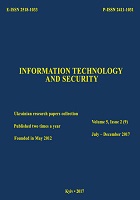Information-telecommunication system, conceptual model of cyberspace and cybersecurity
DOI:
https://doi.org/10.20535/2411-1031.2017.5.2.136981Keywords:
APTs research, information-telecommunication system, cyberspace, cybersecurity, semantic uncertainty of terms, conceptual model of cyberspace, information relations in cyberspace, formal cybersecurity criteria, scenario analysis of APTs.Abstract
The semantic uncertainties between the basic concepts in the field of cybersecurity significantly narrow the range and reduce the effectiveness of scientific research on methods of analysis and forecasting, for example, APT cyberattacks or the development of security complexes based on formal models of proof their effectiveness. The direction of the possible overcoming of the problem is the development of a conceptual model of cyberspace and cybersecurity, which reduces the level of possible uncertainties in describing various complex situations in cyberspace due to the use of special tools terminology, graphics, and mathematical formalization. The beginning of the research - the selected statement: the physical basis of cyberspace are information and telecommunication systems (ITS). The analysis of the information processes of such systems was carried out on the basis of the attributive-transfer approach to the essence of information. It defines “information” how to get the properties (attributes) of the object, reflecting the properties of another object. Electronic devices and physical environments for signal transmission constitute the technological basis of the ITS. Discrete electronic and electromagnetic signals circulating between electronic devices allow the formation of information, transform it and transmit it in space at different distances. Through various sets of electronic devices and signals in the ITS, various information processing technologies are implemented. They provide ITS users with various information services. Users of ITS can be people or technical systems (devices). According to the results of the analysis, a conceptual model of cyberspace and cybersecurity has been developed. The model consists of: 1) a set of interconnected basic terms that reflect the essence of information processes in the ITS. Due to these terms, synthesized definitions for the terms “cyberspace” and “cybersecurity”; 2) graphic model of cyberspace, which explains the ratio of its components; 3) mathematical model of cyberspace is a collection of mathematical constructions based on the theory of sets that specify the nature of the relationship between components of cyberspace. Cyberspace models have developed mathematical cybersecurity criteria for the cyberspace segment. The model also makes it possible to significantly simplify the process of analyzing APT attacks or complex security processes in cyberspace.
References
International Organization for Standardization. (2012, July 16). ISO/IEC 27032:2012. Information technology. Security techniques. Guidelines for cybersecurity.
F. Kramer, S. Starr, and L. Wentz, Сyberpower and National Security. Washington, USA: Potomac Books, 2009.
J.B. Sheldon, “Deciphering cyberpower strategic purpose in peace and war”, Strategic Studies Quarterly, vol. 5, no. 2, pp. 95-112, 2011.
D.V. Dubov, Cyberspace as a new dimension of geopolitical rivalry. Kyiv, Ukraine: NISD, 2014.
Verkhovna Rada of Ukraine. 2nd session. (1994, July 05). Law of Ukraine № 80/94-ВР, On the protection of information in information and telecommunication systems. [Online]. Available: http://zakon3.rada.gov.ua/laws/show/80/94-%D0%B2%D1%80. Accessed on: Aug. 21, 2017.
I.B. Yakoviv, “Communication channel from positions of the attributive-transfer entity of information”, Information Technology and Security, vol. 1, iss. 2, pp. 84-96, 2012.
Verkhovna Rada of Ukraine. 7th session. (2017, Okt. 05). Law of Ukraine № 2163-19, About the basic principles of providing cyber security of Ukraine. [Online]. Available: http://zakon2.rada.gov.ua/laws/show/2163-19. Accessed on: Aug. 21, 2017.
P. Chen, “Chapter 5. A study on Advanced Persistent Threats”, in Communications and Multimedia Security, L. Desmet, and C. Huygens, Eds. Leuven, Belgium: iMinds-DistriNet, 2014, pp. 63-72.
I.B. Yakoviv, “The base model of informational processes of management and safety criteria for cybernetic systems”, Information Technology and Security, vol. 3, iss. 1, pp. 68-73,
D. Schatz, R. Bashroush, and J. Wall, “Towards a More Representative Definition of Cyber Security”, Journal of Digital Forensics, Security and Law, vol. 12 (2). [Online]. Available: https://commons.erau.edu/jdfsl/vol12/iss2/8/. Accessed on: Aug. 21, 2017.
Downloads
Published
How to Cite
Issue
Section
License
Copyright (c) 2020 Collection "Information technology and security"

This work is licensed under a Creative Commons Attribution 4.0 International License.
The authors that are published in this collection, agree to the following terms:
- The authors reserve the right to authorship of their work and pass the collection right of first publication this work is licensed under the Creative Commons Attribution License, which allows others to freely distribute the published work with the obligatory reference to the authors of the original work and the first publication of the work in this collection.
- The authors have the right to conclude an agreement on exclusive distribution of the work in the form in which it was published this anthology (for example, to place the work in a digital repository institution or to publish in the structure of the monograph), provided that references to the first publication of the work in this collection.
- Policy of the journal allows and encourages the placement of authors on the Internet (for example, in storage facilities or on personal web sites) the manuscript of the work, prior to the submission of the manuscript to the editor, and during its editorial processing, as it contributes to productive scientific discussion and positive effect on the efficiency and dynamics of citations of published work (see The Effect of Open Access).

